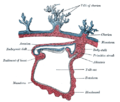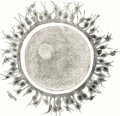 | The blastocyst is a structure formed in the early embryonic development of mammals. It possesses an inner cell mass (ICM) also known as the embryoblast... 22 KB (2,534 words) - 07:09, 14 April 2024 |
 | Implantation (embryology) (redirect from Blastocyst implantation) nidation, is the stage in the embryonic development of mammals in which the blastocyst hatches, attaches, adheres, and invades into the wall of the female's... 51 KB (5,852 words) - 06:09, 27 March 2024 |
 | Embryo transfer (redirect from Blastocyst transfer) Embryo transfer can be done at day two or day three, or later in the blastocyst stage, which was first performed in 1984. Factors that can affect the... 46 KB (5,596 words) - 03:13, 14 April 2024 |
 | Bilaminar embryonic disc (redirect from Bilaminar blastocyst) produce the blastocyst. Once the blastocyst is formed, it undergoes implantation into the endometrium. During implantation the blastocyst, which contains... 11 KB (1,404 words) - 13:51, 29 August 2023 |
 | Embryonic stem cell (redirect from Blastocyst stem cell) derived from the inner cell mass of a blastocyst, an early-stage pre-implantation embryo. Human embryos reach the blastocyst stage 4–5 days post fertilization... 73 KB (8,680 words) - 00:23, 26 April 2024 |
Trilaminar embryonic disc (redirect from Trilaminar blastocysts) A trilaminar embryonic disc, trilaminary blastoderm, or trilaminar germ disk is an early stage in the development of triploblastic organisms, which include... 1 KB (130 words) - 16:32, 14 February 2024 |
Embryo cryopreservation (redirect from Blastocyst cryopreservation) corresponding to pre-implantation, that is, from fertilisation to the blastocyst stage. Embryo cryopreservation is useful for leftover embryos after a... 18 KB (2,141 words) - 12:30, 6 March 2024 |
 | takes the form of the blastocyst by the fifth day of development, just as it approaches the site of implantation. When the blastocyst hatches from the zona... 9 KB (871 words) - 20:31, 30 March 2024 |
 | Blastocoel (redirect from Blastocyst cavity) development. At this stage in mammals the blastula develops into the blastocyst containing an inner cell mass, and outer trophectoderm. It develops following... 13 KB (1,500 words) - 00:08, 23 October 2023 |
 | separate ova by two sperm, followed by aggregation of the two at the blastocyst or zygote stages. This results in the development of an organism with... 56 KB (6,482 words) - 01:01, 16 April 2024 |
 | the blastula. In mammalian development the blastula develops into the blastocyst with a differentiated inner cell mass and an outer trophectoderm. The... 15 KB (1,766 words) - 05:13, 12 January 2024 |
 | Preimplantation genetic diagnosis (redirect from Blastocyst biopsy) for evaluation. Embryos are generally obtained through blastomere or blastocyst biopsy. The latter technique has proved to be less deleterious for the... 110 KB (14,457 words) - 05:18, 15 April 2024 |
step 4 are inserted into a mouse blastocyst. For this example, we use blastocysts from a grey mouse. The blastocysts now contain two types of stem cells:... 15 KB (1,889 words) - 22:25, 7 November 2023 |
fertilization; blastomeres are an essential part of blastula formation, and blastocyst formation in mammals. In humans, blastomere formation begins immediately... 13 KB (1,740 words) - 13:42, 27 October 2023 |
performed are cleavage stage (day 2 to 4 after co-incubation) or the blastocyst stage (day 5 or 6 after co-incubation). Embryos which reach the day 3... 14 KB (1,740 words) - 01:45, 5 March 2024 |
fluid-filled or yolk-filled cavity that forms in the developing blastula or blastocyst in virtually all animal species. The blastocoel appears to serve two functions:... 17 KB (1,491 words) - 17:02, 25 November 2023 |
abnormal sperm morphology does not appear to influence blastocyst development or blastocyst morphology. Even with severe teratozoospermia, microscopy... 4 KB (379 words) - 17:23, 8 July 2023 |
 | blastula (a single-layered hollow sphere of cells), or in mammals the blastocyst, is reorganized into a two-layered or three-layered embryo known as the... 38 KB (4,044 words) - 18:10, 14 March 2024 |










